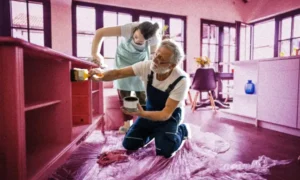Overview
When you’re hunting for a house, it’s easy to fall in love with the charm of older homes in Houston. The high ceilings, ornate trim, and hardwood floors bring a warm feeling. This beauty is usually absent in newly built homes. But, along with all that vintage appeal, you can also expect a lot of maintenance issues coming your way. And safety is also a concern in older homes. These problems might not be visible when buying a beautiful vintage home- but they’re still there, and you can’t ignore these facts.
That’s why, instead of putting your family’s safety and your investment at risk. Why not conduct a thorough modern home inspection on your chosen older property? It would be worth it. Modern inspections for older homes are equipped with all necessary tools and methods – that was not in the last decade’s inspections. Today’s inspectors have technologies and expertise that simply didn’t exist when many Houston homes were originally built.
Modern inspectors know how to spot problems that could cost you tens of thousands down the road. These are the things an average buyer would barely notice when closing on a deal.
GreenWorks Inspections brings this blog post to talk about everything you can expect with a modern home inspection in Houston for older homes. We’ll discuss what to know before buying an older home. And we’ll walk you through the areas an inspector covers during the inspection process. By the end of this blog, you’ll find some helpful tips for inspecting an older home.
So now that you know what to expect from this post, let’s get into it.
What To Know Before Getting An Older Home
Older homes mean old memories and nostalgia for living styles back in time. But it’s also an alarming sign for various problems like termites, damaged roofs, or faulty wiring. That’s why inspecting them thoroughly is unskippable for a buyer. For this purpose, let us take you through the process of what areas are covered in old home inspection in Houston.
Historical Consideration
The best part of older homes is nothing but their history. The stories, memories, culture, and architectural details – no doubt an older home can revive a time period of any region. For instance, the features of vintage homes in Houston include the front door being in the center of the front facade. And the front windows are arranged symmetrically. These are historical features of a home that are revived in one’s mind when buying an older home.
But!
The inspectors view it differently. During an older home inspection in Houston, the inspectors will consider the historical background of a property to investigate if there are any historical designations or restrictions on the property.
Getting approval for exterior updates or renovations on historically designated homes can be tricky. There may even be mandates to maintain certain original features, which gets expensive. These are the areas covered during the inspection.
Structural Integrity
While charming, old homes often have settled foundations, which can pull you into a vicious cycle. Professional inspectors also look for outdated framing, cracked walls, and floors that sag. A thorough inspection checks for structural issues that are notoriously pricey to fix. The inspectors also spot any signs like sticking doors, sloping floors, and exterior cracks. While skipping an inspection on an older home can cost you a fortune on modern repairs.
Electrical Wiring
Outdated electrical systems can present serious fire and safety issues. That’s what old home inspections deal with. The inspectors look for outdated electrical systems and faulty wiring and outlets. Aluminum wiring from the 1960s-70s is especially hazardous. The inspectors also assess fuse boxes, undersized panels, and insufficient outlets – for modern needs, these are other red flags.
Roof Condition
The inspectors carefully look for the roof condition for structural stability, proper drainage, and any water pooling or leaks. Lifespans for roofs range from 15-30 years. By 50 years, it will likely need replacing, no matter what shape it appears in on the surface.
Pest Infestation
Aging homes mean termites and pests have their ways open to it. They like to munch on wooden structures and soft materials in older homes. That’s what modern inspectors look for. They inspect your chosen older home for termite exposures, their tracks, and colonies. They also check for past water damage that can attract future invasions.
Insulation & Energy Efficiency
Poor insulation makes for costly utility bills and discomfort. The inspectors look at your place for poor insulation, higher energy consumption, or heat-losing areas. They may suggest improvements like blown-in wall insulation and modern HVAC units. A proper inspection can save you from spending a fortune on serious efficiency overhauls.
Resale Value
Buyers in older times would hardly care about the property’s resale value. They would buy charming older properties, no questions asked. But as consumer savvy increases, people prefer thorough home inspections to make more informed decisions before buying a property.
Imagine getting an older home without any inspection. Although the curb appeal sells, the outdated layouts, expensive repairs, and energy gaps will still be passed on to you. That’s where thorough home inspection saves you. Inspecting your older home will help you get more insights into its marketability and ROI potential.
Maintenance Costs
Even well-kept older homes have more upkeep needs than new builds. Repainting, roof repairs, tree trimming, window replacement, and many repair and maintenance costs would be waiting for you ahead. But, inspecting and addressing these problems on time can save you from repetitive expenses. This way, you can also set a maintenance budget aside for any unexpected issue. However, it really depends on the house’s size and condition.
Areas Covered in Older Home Inspections In Houston
Getting modern inspections on older Houston homes saves you from overpaying for a property. You will be well aware of hidden risks and repair needs. Work with the inspectors to understand the latest methods to uncover all issues before locking the deal.
Outdated Building Materials
Inspectors check for harmful materials like lead paint and asbestos insulation. They also look for code violations, like exposed knob-and-tube wiring. Which requires a complete overhaul to meet modern safety standards.
Structural Issues
The professional inspectors keep signs of foundation problems, shifted walls, problematic additions, and settling on their radar. They probe for cracks, rotting roof beams, and other instabilities that can risk structural integrity over decades.
Functional Issues
The inspections reveal any functional issues to ensure doors and windows shut properly and are robust enough. They also confirm if the electrical appliances and devices are sufficient. Inspectors test the functionality of fixtures, outlets, mechanicals, appliances, vents, and more. And if the floors and levels.
Plumbing Concerns
The older homes must be passed through plumbing assessments. The galvanized pipes and cast-iron drains can have rust, leaks, and clogs accumulated for years. Causing water damage and mold. Inspectors check pipe materials and functionality.
Hidden Defects
Good inspectors tap their experience to uncover issues hidden behind walls or under flooring. They look for signs of past termite damage, water leaks, fire damage, and other expensive defects – often lurking out of sight.
Costs of Repairs
Inspectors include repair estimates so buyers understand the potential costs ahead. They look up local contractor quotes for big projects like foundation work, drainage installation, rewiring, and roof replacements.
Tips for Inspecting Historic Houses Before You Buy
Doing your homework on inspections protects against overpaying for outdated or hazardous historic homes. So here are some tips for inspecting historic houses before you buy one.
Review the Home’s History
Do some digging into the background of any historic house you’re considering. Check if there are historical designations, which can limit changes you can make. Also, research permits, renovations, major repairs, or problems through the years. This clues you into conditions.
Assess Accessibility Challenges
Historic layouts often pose accessibility issues, with narrow halls, tight spaces, and stairs everywhere. If your mobility is limited now or maybe someday, evaluate if a historic home will still function for your needs.
Look for Common Wear-Related Issues
Plumbing, electric, walls, windows, roofing – old home components simply wear out. Check the age and condition of systems, structure materials, appliances, and fixtures. Also sniff for musty smells signaling leaks. Replacement costs add up fast.
Bring Testing Equipment
While visual inspections reveal a lot, meters and testing tools uncover even more issues hiding behind walls and under flooring. Moisture meters, thermal imaging cams, electrical testers and more help assess safety hazards and needed upgrades.
FAQs
Is Your House Aging Appropriately?
If a historic home seems suspiciously well-preserved, beware. Layers of cosmetic fluffing may hide serious defects the owner doesn’t want you to find. Make sure inspectors check behind walls and under flooring for problems.
What If An Older Home Inspection Fails Badly?
If inspection issues exceed your repair budget or comfort level, be ready to walk away. Don’t let charm blind you. However, moderately priced fixes that allow you to maintain original historical features may be worth it if the structure is sound.
Common Issues Found in Older Homes
Outdated electric systems, bad roofs, old plumbing, pest damage, hazardous materials like asbestos and lead paint, sinking foundations, and expensive HVAC upgrades for energy efficiency are typical problems facing older homes.
Does an Older Home Inspection Cost More Than a Newer One?
Yes – more complex systems, vast inspection areas, and additional testing required mean more time and tools. Historic house inspections cost more than newer homes.
Bottom Line
The bottom line is that meticulous modern home inspections in Houston protect buyers from unaware challenges of older homes. The experienced inspectors are armed with the latest technologies and uncover hidden issues in older homes. Being an informed buyer is the best policy!



































